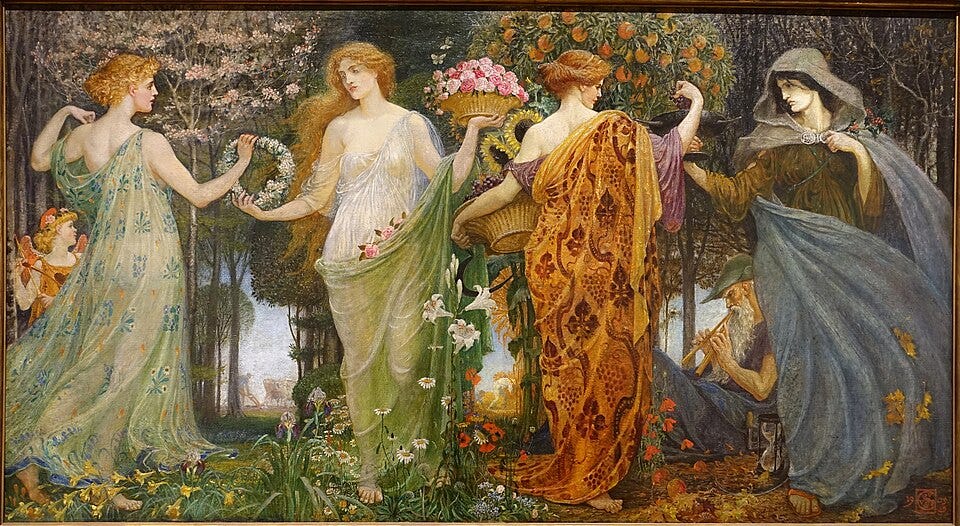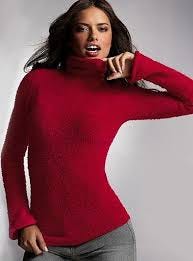Your Color Season Can Change!!!!
I bet your ass didn't even know you had a color season
Maybe you would like to look nice. A lot of people do. Maybe you’re reading this thinking what the hell are color seasons. And maybe you are pretty bad at copying people, but you’re some combination of analytically minded and aesthetically sensitive. In which case you might be better off not reading this antinomian deconstruction of color seasons, and instead, reading about color seasons. I love the Truth is Beauty color analysis system.
I asked non-color-season-knowers what they thought color seasons were. “It’s fashion saying you should wear different colors in different seasons, so they can sell more clothes.” No, but put a pin in that. “Oh, I know this one, autumns should wear red and orange like autumn leaves. And springs should wear pink!” Also no, but this is the level at which color analysis functions in the general discourse: that there are specific colors, describable at a pretty low specification like “red” or “blue” or “orange,” that some people should wear and some people shouldn’t.
Also, from the “seasons” thing, you would guess there are four types. And that’s how things started. But now, you see systems with up to eighteen different seasons (Truth is Beauty posits a manageable twelve), and one analyst’s Soft Autumn is not necessarily another analyst’s Soft Autumn.
The basic, generally-agreed-upon-at-this-point idea:
people differ with respect to which colors look natural on them, with regard to hue (cool or warm), value (light or dark), & chroma (soft or bright),
people are sortable into defined-ish types called “seasons” based on these categories
every color describable in a single word (“pink,” “orange,” “blue”) has variations in hue, value, and chroma, such that there can be a warm bright light red (which would look good on a certain type of spring) or a cool soft dark red (which would look best on a certain type of summer).
Anyway. I won’t explain everything, greater minds than mine have gotten into more depth on this. Also, you don’t have to stick to your seasonal palette to find seasonal analysis useful: if you want to dress goth but are cursed to look vibrant in black, you might be well-served by buying clothes in a dark Autumnal purple which washes you out; someone who wants to dress in a gyaru style but who looks natural in bubblegum pink, might want to hit neon green or bright aqua. Also, there are schisms, for instance some analysts are season rationalists who believe you can deduce someone’s season from their hair color, eye color, etc, whereas others such as myself are season empricists who think you need to see someone in a bunch of colors before you can type them (I think I’m getting rationalism vs empiricism slightly wrong & also this is absolutely not the terminology most color analysts would use here).
You can see how the sharp dividing lines and crisp aesthetic rules would be really appealing if you were, for instance, a recently homeschooled kid, wearing a scarf you knit out of some garish eyelash yarn, watching groups of girls go by in coordinating outfits, wondering who copied who, and how they knew what to copy, how they knew it was the sperries that were salient and not, say, the color of the shirt.
But there’s something that almost every color-season-believer agrees on, a principle which is almost foundational to the color season ideology, and in which I am increasingly coming to lose faith: the idea that color seasons are immutable, that once you’ve found your true season, you’re set for life.
People are always trying to change their season. A lot of people try to change their season by dying their hair or wearing makeup, and this straight up just doesn’t work. (When people say they can “always tell” dyed hair or makeup, they are wrong, airplane dot emoji, but imo what they’re actually noticing is off-season palettes.1 Visibly “heavy” makeup, in my opinion, has much less to do with the actual amount of pigment you’re putting on, much more to do with picking off-palette colors.2) And color season believers rightly tell them, hey, it doesn’t work that way.
But then, for whatever reason, color season believers will say that tanning can’t change your season. Some of them will reluctantly admit that aging might change your season, but many others will insist that aging just pushes you to another part of your seasonal palette. Often, people get a little mystical with it, talking about skin color in terms of “overtones,” which are visible and subject to change, and “undertones” which are unchanging and invisible to the naked eye.
I tried to believe it. But it just doesn’t stand to reason. There is no eternal undertone. There is only tone, ever-shifting in response to conditions. Tanning changes your season, changing the melanin levels in your skin. Your shifting cardiovascular health changes your season, changing the redness of your skin. Your diet changes your season, changing the levels of yellow beta-carotene and red lycopene in your skin.
Which doesn’t mean that people don’t have different complexions. But it’s probably a better approximation of the world, a better use of color season theory, to think of people as inhabiting a specific range of color seasons, responding differently to changes in melanin, hemoglobin, beta-carotene, and lycopene. Maybe someone can carry high chroma in the winter, but tanning mutes that. Maybe someone else’s coloring is so muted naturally that a tan lets them carry more chroma. I took a workout class led by a friend who’s a spring, maybe a Bright Spring; we both flushed from our hearts working harder, but she looked in some sense “the same as usual,” on an axis where I looked “different from usual.” (Athletic wear is usually brighter than, like, officewear; maybe it’s literally because people’s skin has more pigment during a workout???)
Anyway. I got a little tan recently, and I was emboldened to buy a golden-brown romper with off-white flowers, solidly outside the range of colors prescribed by my Winter self-diagnosis in high school. I know empirically that I would look like trash in this color without a tan. But when the hell am I going to be wearing a thin cotton romper with fluttery little shorts and not have a tan???? So now we’re back to “color seasons are the colors you wear in different seasons.” I think I’m a summer in the winter and an autumn in the summer, confusingly enough. The three identical wrap dresses I wear almost constantly, like a cartoon character, are a sagey-minty green that works for both.
I don’t know if this is the kind of content you’re here for, but it’s what I’m thinking about, so it’s what you’re getting. Sorry to everyone who would prefer for seasonal analysis to be less fuzzy-logic, I too wish I could believe in the firm lines like I used to.
Which, again, can be an aesthetic choice. Sometimes you want to look wan or artificial.
Or….they’re noticing someone has picked makeup textures which don’t harmonize with your type of beauty. Which has very little to do with picking textures that are natural, in terms of “it is possible for skin to have this texture naturally,” although the effect will be natural on the wearer. For instance: a woman with dramatic bone structure will look “natural” in makeup that is far more matte or far more glossy than skin ever naturally is. But this is a whole ’nother issue that I probably shouldn’t have raised here.





What do you think about natural hair color changes affecting season?
Kids' hair darkens as they get older; gray/white hair changes your overall color palette; since reddish hairs tend to gray fastest, aging probably turns some "autumns" into "winters".
re: your footnote... please write the makeup post too <_< I would upgrade to paid for that lol